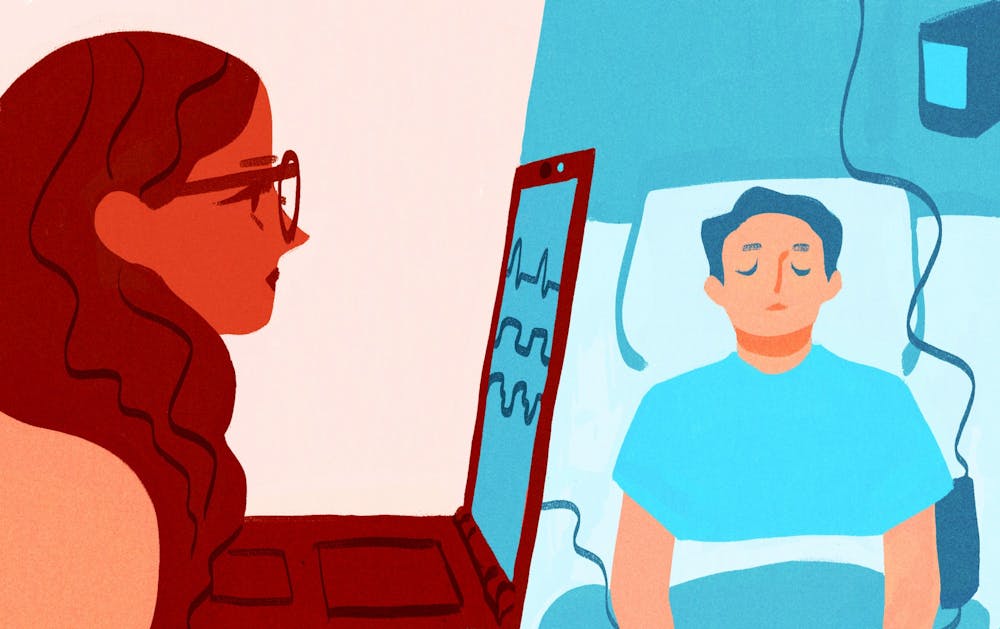When ASU announced courses would be held online for the rest of the spring semester due to the COVID-19 pandemic, instructors at the Edson College of Nursing and Health Innovation had a unique challenge: adapting courses designed for experiential, hands-on learning to a remote digital environment.
In their junior and senior years, pre-licensure nursing students participate in experiential courses that simulate clinical environments using mannequins and medical equipment in the Edson College’s simulation suites. Typically, pre-licensure students receive half of their clinical learning in courses like these.
Rather than revamp experiential courses to use more traditional online methods, instructors and staff at the Grace Center for Innovation in Nursing Education transitioned the entire operation online so students could interact with the same simulations from their homes as they did in their in-person classes.
Margaret Calacci is the director of the Grace Center for Innovation in Nursing Education and directed this transition to online learning. She leads a 10 person team that includes five simulation, or sim, nurses who operate the simulation labs used in experiential courses. Over spring break, they tackled the challenge of creating a comparable digital experience to the normal immersive style of the courses.
To bring the simulation lab experience to students’ screens, sim nurses drew from existing clips of students working in the labs, created PowerPoint presentations including a digitized medication station and name bands that identify patients, and used programming screens to show vital signs that change in response to students’ actions in the simulation.
“Monday was a little rough, Tuesday was a little better, Wednesday was pretty good, by Thursday I think we really had it down,” Calacci said. “This week we started pretty strong and have been able to adapt to the environment.”
In each class, instructors and sim nurses use Zoom to allow students to interact with patient simulations remotely. The students work in pairs to make decisions when interacting with the patients and are encouraged to stand up and think out loud while in the Zoom simulations.
Although students are unable to physically interact with the patients, standing and speaking out loud helps to emulate the in-person experience, Calacci said.
Sydney Alcorn is a junior nursing student beginning her first clinical experience this semester. Although she's sad she won’t be able to meet with real patients, she appreciates the effort her professors have put into adapting the clinical environment to online learning.
“I think our professors are really working extremely hard,” Alcorn said. “We get emails all throughout the day and night with them updating us and trying to keep us on track. So I think they're really good at trying to work with what they had, and I'm just really grateful for them.”
Before spring break, senior nursing student Sarah Ray finished the first half of her final experiential course before graduation.
In the first half, she participated in simulations where she treated two different patients in the simulation lab. For the second half of the course, she is mentoring students in earlier stages of their nursing degrees who are going through the same experiential courses, but now held online.
“I think in a lot of ways, being able to tell them what it looked like when I was in the sim kind of helps them get a better picture of what the sim was supposed to look like,” Ray said.
Having the course online allows Ray to better interact with professors when her mentees are working together in the simulations because she can use Zoom’s private chat function to make sure they are all on the same page, she said.
Emily Rennecker is a junior nursing student who would have started her clinical experience in person this week, but is now doing it online.
“One of the big benefits that we have is that the professors all work together across all semesters,” Rennecker said. “So they know next semester that we haven't had that hospital in-person experience.”
In response to the lack of in-hospital experience Rennecker and her peers had this semester, professors will hold a boot-camp style course at the beginning of next semester for students to use real equipment to practice the skills they are learning online before moving forward in their education.
Although it was not what they originally hoped for, many nursing students see the changes made this semester due to the pandemic as a chance to practice flexibility and adaptability — important attributes for future nurses.
“You just have to take every opportunity to learn, because by doing that, we build our knowledge base and then we can further help other people,” Ray said.
Correction: A previous version of this story misstated the number of simulation nurses on the team. There are five simulation nurses, and the story was updated to reflect the change.
Reach the reporter at gforslun@asu.edu and on Twitter @GretaForslund.
Like The State Press on Facebook and follow @statepress on Twitter.
Continue supporting student journalism and
donate to The State Press today.




